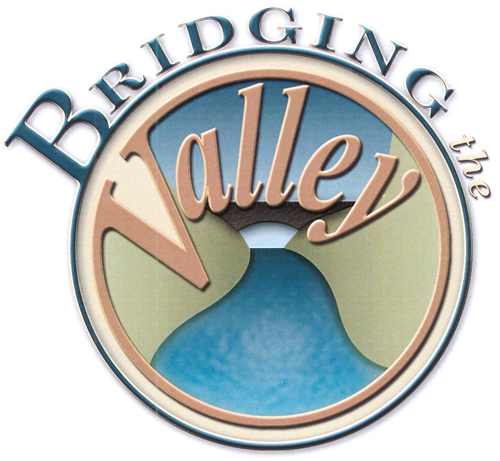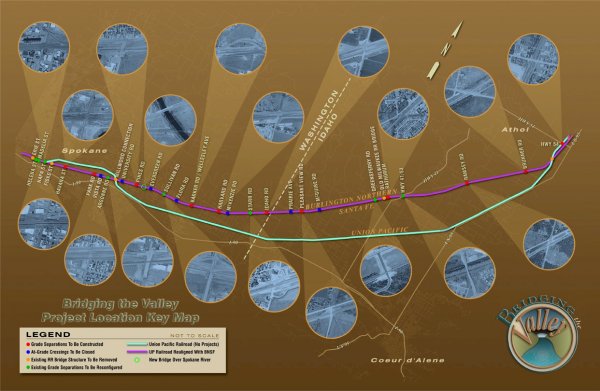
Bridging the Valley
Bridging the Valley (BTV) is a 2006 study that proposes separating vehicle traffic from train traffic in the 42 mile corridor between Spokane and Athol, ID. A map of the corridor and proposed projects sites is below.
The separation of railroad and roadway grades in this corridor—which includes 75 railroad/roadway crossings—is intended to promote future economic growth, traffic movement, traffic safety, and train whistle noise abatement. By removing at-grade rail crossings, Bridging the Valley proposes to:
- Improve public safety by reducing rail/vehicle collisions;
- Improve emergency access to residents and businesses along the corridor;
- Eliminate wait times for cars and trucks at rail crossings;
- Reduce noise levels; especially train whistles, near crossings;
- Improve traffic flow due to separated grade crossings; and
- Enhance development opportunities with a single rail corridor served by the region’s largest railroads.
What Does BTV Include?
The complete BTV project, as originally envisioned, would:
- Construct approximately 19 separated grade crossings within the BNSF corridor. This would modify eight existing crossings and create approximately 11 additional grade separated crossings.
- Construct additional track capacity on the BNSF corridor between Spokane and Athol, which currently consists of both single and double mainline track. This area would be expanded by generally adding one track—with occasional need for two additional tracks in some locations—to the existing mainline within the railroad right of way;
- Install improvements to the existing Centralized Train Control signaling system;
- Construct a new two-track bridge over the Spokane River;
- Provide other track improvements in yards and connections; and
- Remove a majority of the UPRR mainline and the associated crossings.
Currently there are no plans to complete Bridging the Valley in its’ entirety. Funding is limited and projects are being considered for construction as money becomes available. SRTC’s long-range transportation plan, Horizon 2040, includes a list of projects and programs recommended to be completed by 2040. This list includes three BTV projects that are considered “regionally significant.” The three projects are:
- Barker Road Overpass
- SR27/SR290 (Pines Road) Underpass
- Sullivan Road Bridge
SRTC classifies a project as regionally significant if it:
- Cannot be grouped in the Transportation Improvement Program (TIP) and/or State TIP (STIP), and/or it is not listed as an exempt project type in the Environmental Protection Agency’s (EPA’s) regional transportation conformityregulation (40 C.F.R. part 93); and
- Is on a facility which serves regional transportation needs (federally classified as a principal arterial, highway or freeway) and alters the number of through-lanes for motor vehicles for a length greater than a half mile, or impacts a freeway or freeway interchange (other than maintenance projects); or
- Is a new or extended fixed guideway transit service (dedicated bus lanes, vehicle track or wires) or capital expenditures related to a new fixed-route transit service on a facility which serves regional transportation needs (federally classified as principal arterial or higher).
- Is determined by the SRTC Policy Board to be regionally significant or have the potential for adverse emissions impacts for any reason.
Regional decision makers continue to evaluate the priority of BTV projects annually. It is possible that the status of those projects could change in the future and with updates to Horizon 2040 in coming years.
The map below shows the overall alignment of projects and associated roadway and railroad grade crossings. Click on each of the grade crossings for more information and detail or click the link below the map for the fact sheet for each individual project. For fact sheets in a Word document format, please email contact.srtc@srtc.org or call (509) 343-6370.

